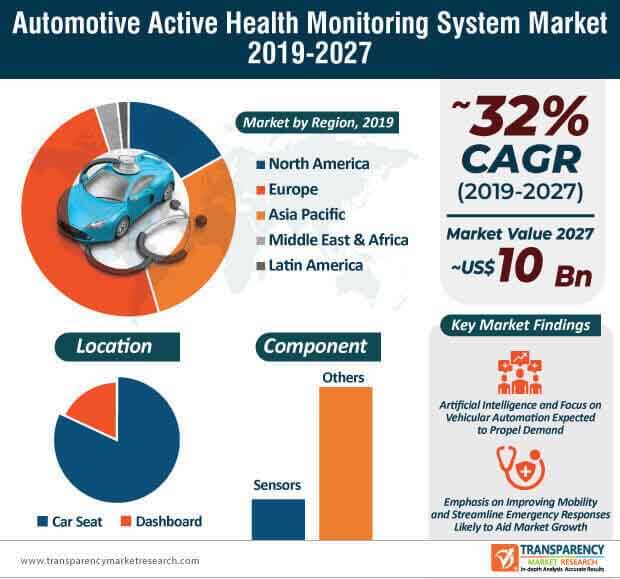
The automotive industry has evolved at a rapid pace over the past couple of decades. With significant advancements in vehicle automation and artificial intelligence (AI), connected and automated vehicles (CAV) are likely to play an important role in the current and next-generation urban transportation systems. Within the automotive sector, an array of institutions, including universities, public agencies, and major companies are working in tandem with each other to explore the potential benefits of these technologies in the automotive sector. Over the past few years, automotive active health monitoring systems have gained significant popularity and the trend is set to continue during the forecast period.
Companies in the healthcare sector and the automotive sector are increasingly collaborating with each other to improve passenger safety in automated vehicles. Players operating in the automotive active health monitoring system market are eyeing opportunities within the automotive sector, as the demand for automotive active health monitoring systems continues to surge. Improved vehicle & occupant safety, efficient passive health monitoring, rapid emergency responses, and improved mobility, along with the rise in the number of road accidents worldwide have played a key role in the adoption of automotive active health monitoring systems. At the back of these factors, the global automotive active health monitoring system market is expected to surpass the ~US$ 10 Bn mark by the end of 2030.

Request a sample to get extensive insights into the Automotive Active Health Monitoring System Market
Technological Advancements Accelerate Adoption of Automotive Active Health Monitoring Systems
Technological advancements and innovations are expected to play an important role in the expansion of the global automotive active health monitoring system market. The crossover between the health sector and the automotive sector has resulted in a staggering surge in the adoption of automotive active health monitoring systems. At present, steering wheels and seat belts can offer real-time data pertaining to the driver’s health. Although the technology is at a relatively nascent stage, pairing automotive active health monitoring systems with wearable technology is a trend that is set to gain significant traction in the coming years. Advancements in the electronics and microelectronics space have led to a significant rise in the development of cost-effective devices that are increasingly being used as monitoring tools.
To understand how our report can bring difference to your business strategy, Ask for a brochure
The demand for remote health monitoring wherein non-invasive wearable sensors, cutting-edge information technologies, and actuators are used have played an important role in increasing the safety of passengers in automated vehicles. Progress in sensor technologies is another major factor that is projected to accelerate the expansion of automotive active health monitoring system market in the coming years. Healthcare companies collaborating with insurance companies require real-time, accurate, and reliable diagnostic results offered by sensor systems, which can be closely monitored in hospitals, clinics, etc. The advent of smart sensors have paved the way for advanced automotive active health monitoring systems and boosted the integration of digital healthcare and the Internet of Things (IoT). Furthermore, strides taken by mechanically flexible, integrated, and multiplexed sensor systems are projected to boost the prospects of the global automotive active health monitoring system market during the assessment period. Within the global automotive active health monitoring system market, the adoption of health monitoring systems to monitor pulse and blood sugar is on the rise– a trend that is expected to continue over the coming decade. The advent of the 5G technology and advancements in machine learning and high uptake of the Internet of Things (IoT) is likely to open up several opportunities for participants operating in the current automotive active health monitoring system market landscape. As governments across the world continue to focus on minimizing the number of road accidents, the demand for cutting-edge automotive active health monitoring systems is anticipated to grow at an impressive pace.
COVID-19 Pandemic Dents Automotive Production, Market Players to Seek Opportunities in Healthcare Sector
The advent of the novel coronavirus pandemic has majorly impacted the automobile production worldwide. While the production of automobiles is projected to decline over the next couple of months, the demand for automotive active health monitoring systems is likely to remain sluggish as well. The assembly lines in different fast-moving production industries, including the automotive sector are being affected and companies operating in the automotive active health monitoring system market are expected to target those that have incorporated agile manufacturing processes and supply chains to mitigate losses. In addition, companies in the current market landscape should also eye opportunities in the healthcare sector and identify the different pockets wherein the demand for active health monitoring systems is high to ensure cash flow. Product development and diversification coupled with value addition is expected to remain the key for companies in the upcoming months.
Read Our Latest Press Release:





